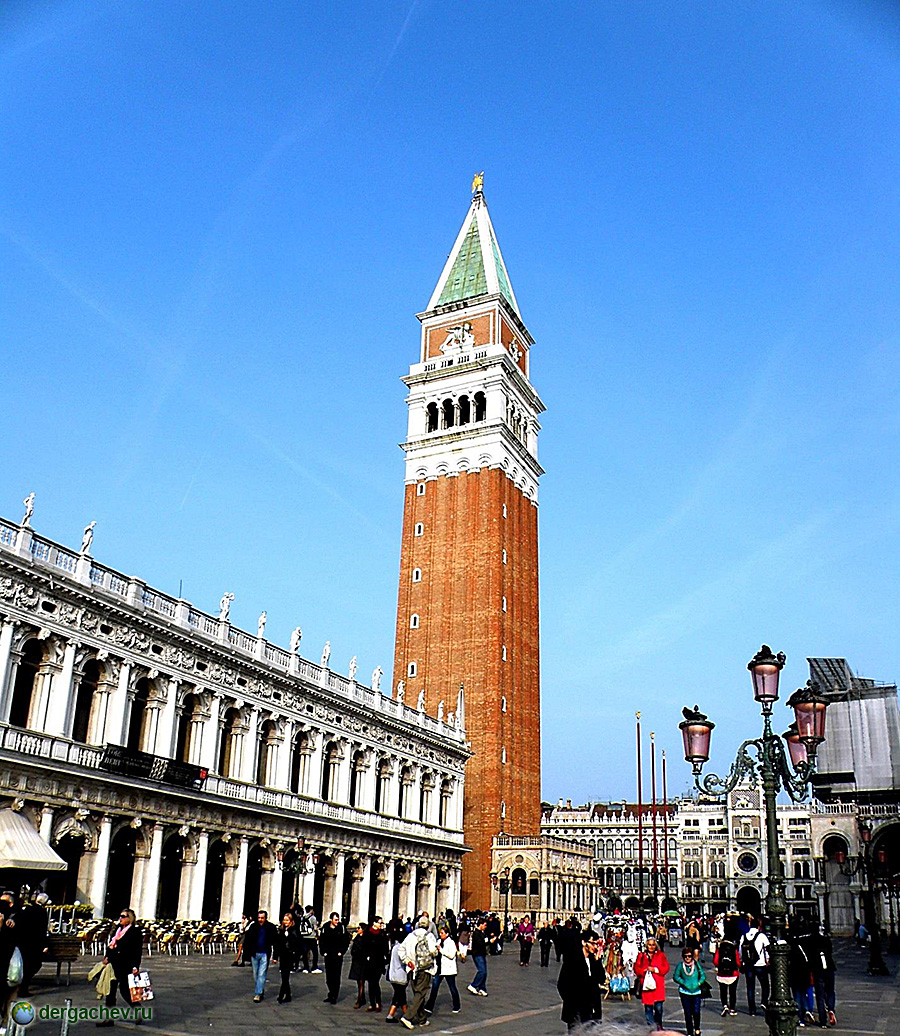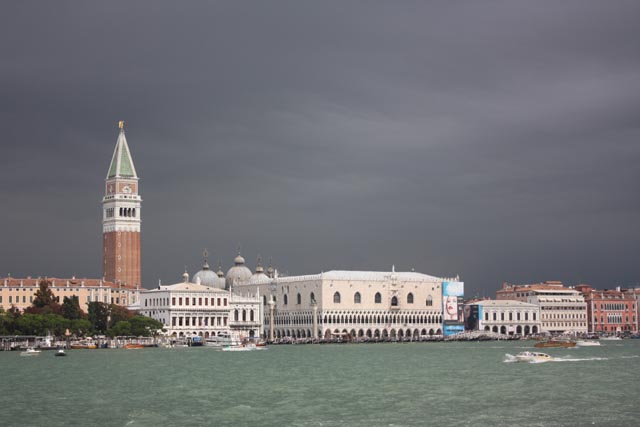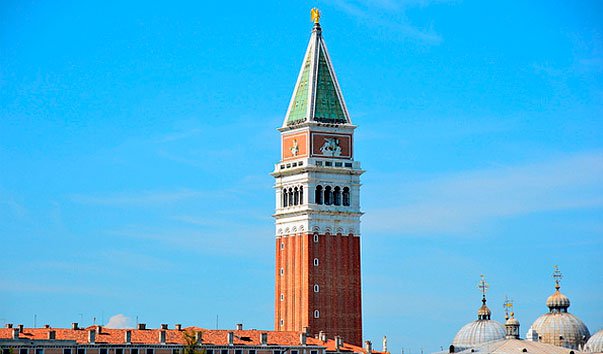St Mark's Campanile (Campanile di San Marco in Italian) is the bell tower of St Mark's Basilica in Venice, Italy, located in the Piazza San Marco. It is one of the most recognizable symbols of the city.
The tower is 98.6 metres (323 ft) tall, and stands alone in a corner of St Mark's Square, near the front of the basilica. It has a simple form, the bulk of which is a fluted brick square shaft, 12 metres (39 ft) wide on each side and 50 metres (160 ft) tall, above which is a loggia surrounding the belfry, housing five bells. The belfry is topped by a cube, alternate faces of which show the Lion of St. Mark and the female representation of Venice (la Giustizia: Justice). The tower is capped by a pyramidal spire, at the top of which sits a golden weathervane in the form of the archangel Gabriel. The campanile reached its present form in 1514. The current tower was reconstructed in its present form in 1912 after the collapse of 1902.
The initial 9th-century construction, initiated during the reign of Pietro Tribuno and built on Roman foundations,[1] was used as a watch tower or lighthouse for the dock, which then occupied a substantial part of the area which is now the Piazzetta. Construction was finished in the twelfth century, during the reign of Domenico Morosini. Adjoining the base of the campanile is the loggetta built by Sansovino, completed in 1549 and rebuilt in 1912 after it had been destroyed by the fall of the campanile. One of the models for the tower was the St. Mercuriale's Campanile, in Forlì.
The campanile suffered damage by lightning on many occasions. It was severely damaged in 1388, set on fire and destroyed in 1417 and seriously damaged by a fire in 1489 that destroyed the wooden spire.
The campanile assumed its definitive shape in the sixteenth century thanks to the restorations made to repair further damage caused by the earthquake of March 1511. These works, initiated by the architect Giorgio Spavento, then executed under the direction of Bartolomeo Bon of Bergamo, added the belfry, realized in marble; the attic, on which was put the sculpture of the lion of Saint Mark and Venice; and the spire, in gold leaf. The work was completed on 6 July 1513, with the placement of the gilded wooden statue of the Archangel Gabriel in the course of a ceremony recorded by Marin Sanudo.
In the following centuries numerous other interventions were made to repair the damage from fires caused by lightning. It was damaged in 1548 and 1565. In 1653, Baldassarre Longhena took up the restorations. The campanile was damaged by lightning again in 1658.More work was done after a fire caused by a lightning strike on April 13, 1745, which caused some of the masonry to crack, and killed several people as a result of falling stonework. The campanile was damaged by lightning again in 1761 and 1762. Finally, in 1776, it was equipped with a lightning rod.
In 1820, the statue of the angel was replaced with a new one by Luigi Zandomeneghi.
In July 1902, the north wall of the tower began to show signs of a dangerous crack that in the following days continued to grow. Finally, on Monday, July 14, around 9:45 am, the campanile collapsed completely, also demolishing the logetta. Remarkably, no one was killed, except for the caretaker's cat. Because of the campanile's position, the resulting damage was relatively limited. Apart from the logetta, only a corner of the Biblioteca Marciana was destroyed. The pietra del bando, a large porphyry column from which laws used to be read, protected the basilica itself.
The same evening, the communal council approved over 500,000 Lire for the reconstruction of the campanile. It was decided to rebuild the tower exactly as it was, with some internal reinforcement to prevent future collapse. Royal Privy Councillor and scaffolding specialist Georg Leib of Munich was the first to donate his scaffolding to rebuild St. Mark's Campanile, on July 22nd, 1902. Work lasted until March 6, 1912. The work was carried out by the construction firm of G.A.Porcheddu. The new campanile was inaugurated on April 25, 1912, on the occasion of Saint Mark's feast day, exactly 1000 years after the foundations of the original building had allegedly been laid.












